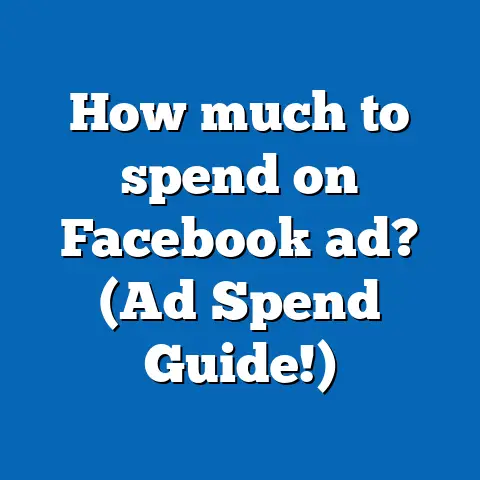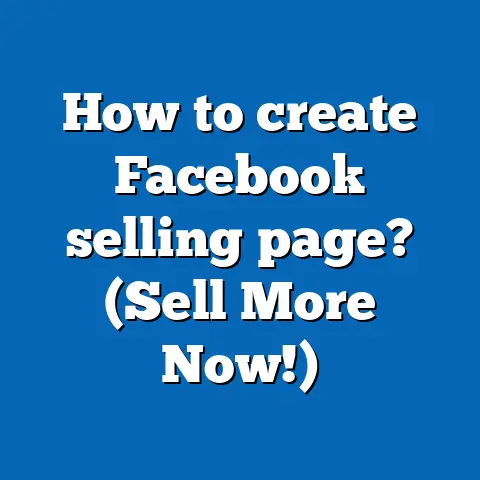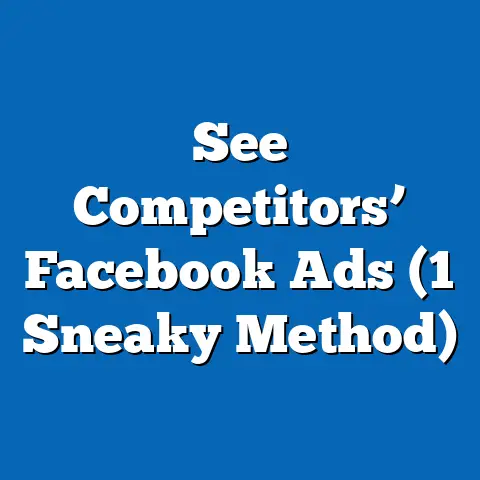Spy on Competitors’ Facebook Ad Targeting (5 Hacks)
The Paradox of Transparency: Secrets Hidden in Plain Sight
Isn’t it funny how the most powerful secrets are often hidden right under our noses? In the world of Facebook advertising, spying on competitors might seem like a clandestine operation, but it’s actually a game of transparency. So, how do we leverage this paradox to gain an edge in our ad campaigns? Let me walk you through 5 hacks to uncover your competitors’ Facebook ad targeting strategies and harness those insights for your own success. We’ll explore everything from sneaky tricks to official tools, and by the end, you’ll be ready to take your ad game to the next level.
Our Journey Begins: What You’ll Learn
In this guide, I’ll share my personal experiences and insights on how I managed to decode competitors’ ad strategies. We’ll cover practical steps and tips to help you:
- Understand competitors’ targeting and messaging
- Identify gaps in your own strategy
- Optimize your ad spend for better results
Are you ready to dive into the world of Facebook ad espionage with me? Let’s get started!
Hack 1: Dive into the Facebook Ad Library
Ever wondered how easy it is to sneak a peek at what your competition is up to? The Facebook Ad Library is like a treasure trove of information, accessible to anyone with a curious mind.
How It Works
The Ad Library provides transparency for all active ads on Facebook. You can search by brand or keyword and see exactly what ads are running.
- Visit the Ad Library: Head over to Facebook Ad Library.
- Search for Competitors: Type in your competitor’s name or related keywords.
- Analyze Their Ads: Look at their ad copy, images, videos, and call-to-actions.
Personal Touch: I remember stumbling upon a competitor’s ad that had been highly engaging. They used a catchy video that I hadn’t thought of before. Inspired by this discovery, I crafted my own version and saw a significant boost in engagement.
Why It’s Useful
By examining the creative elements and messaging of your competitors’ ads, you can identify trends and gaps in your own strategy. It’s like having a free pass to their brainstorming sessions!
Deep Dive: Analyzing Creative Elements
When delving into the creative aspects of competitors’ ads, pay attention to:
- Visual Styles: Are they using bright colors or minimalistic designs?
- Copywriting Techniques: Notice if they use humor, urgency, or storytelling.
- Call-to-Action (CTA): How are they encouraging users to take action?
Reflecting on these elements helped me understand my audience better. For instance, when I noticed a trend towards minimalistic visuals, I pivoted my campaign designs accordingly. This change resulted in a noticeable uptick in click-through rates (CTR).
Tools and Techniques for Better Analysis
Consider using additional tools like:
- BuzzSumo: To identify trending content themes.
- Canva Color Palette Generator: To analyze color schemes.
- Grammarly Tone Detector: For assessing the tone of ad copy.
These tools can help provide a more nuanced understanding of what might be working for your competitors.
Hack 2: Tap Into Audience Insights
Have you ever wondered who exactly your competitors are targeting? Facebook’s Audience Insights tool can give you a sneak peek into potential audience demographics.
Step-by-Step Guide
- Access Audience Insights: Log into your Facebook Business Manager account.
- Choose Your Audience: Select “Everyone on Facebook” to start with a broad view.
- Filter by Interests and Competitors: Enter interests related to your niche or specific competitor pages.
- Analyze Demographics: Check out age, gender, location, and even page likes.
Example: I once discovered a competitor targeting an unexpected age group. By adjusting my own campaign to include this demographic, I tapped into an entirely new customer base.
Benefits
Understanding who your competitors are targeting helps tailor your content and reach new audiences you hadn’t considered before.
Expanding Your Reach: Niche Targeting
One of the fascinating things I learned through Audience Insights was niche targeting. By digging deeper into competitors’ audience interests, I uncovered sub-groups that were previously overlooked.
Technical Details: Costs and Specifications
While Audience Insights itself doesn’t cost anything extra within Facebook Business Manager, it can save substantial costs by refining your targeting strategy:
- Reduced Ad Spend: By focusing on audiences with proven interest, I reduced wasted impressions.
- Increased ROI: Tailored ads resulted in higher conversion rates.
Understanding these aspects can empower you to make more informed budget decisions.
Hack 3: Leverage Social Listening Tools
Ever feel like you’re missing the buzz around your competitor’s campaigns? Social listening tools can help you keep tabs on conversations and mentions related to their brands.
Tools You Can Use
- Hootsuite Insights
- Brandwatch
- Mention
How to Set It Up
- Choose a Tool: Pick a social listening tool that suits your needs and budget.
- Set Up Alerts: Create alerts for competitor names, product mentions, and industry keywords.
- Monitor Conversations: Analyze the sentiment and volume of conversations.
Story Time: I once used Hootsuite Insights to track a competitor’s new product launch. By monitoring customer feedback, I identified pain points and refined my own product messaging to address those concerns.
Why It Matters
Social listening provides insights into customer sentiment and brand perception, allowing you to adapt your strategies in real time.
Expanding on Real-Time Adaptation
One weekend, while analyzing social sentiment around a competitor’s campaign, I noticed an influx of negative comments relating to shipping delays. Capitalizing on this insight:
- Immediate Action: We quickly promoted our reliable shipping policies via social media ads.
- Result: Not only did this strengthen our brand image but also led to a surge in weekend sales.
Technical Insights: Setting Up Efficient Alerts
Setting up efficient alerts involves understanding key phrases or brand-specific jargon that audiences use:
- Use Boolean operators (AND, OR) within tools for precise results.
- Include long-tail keywords specific to product features or complaints.
This approach ensures you’re capturing relevant conversations without unnecessary noise.
Hack 4: Study Their Landing Pages
Have you considered what happens after someone clicks on a competitor’s ad? Studying their landing pages can reveal a lot about their conversion strategies.
Steps to Analyze Landing Pages
- Click & Explore: Use links from the Ad Library to visit competitors’ landing pages.
- Examine Layout & Content: Pay attention to headlines, offers, and calls-to-action.
- Identify Unique Selling Points (USPs): What makes their offer stand out?
Example: During one campaign analysis, I noticed a competitor emphasizing “free shipping” prominently on their landing page—something I hadn’t highlighted enough. Adjusting my landing page accordingly led to a noticeable increase in conversions.
The Advantage
Evaluating landing pages helps you understand how competitors are guiding customers through the sales funnel, allowing you to refine your own approach.
Deep Dive: Conversion Rate Optimization (CRO)
Analyzing competitors’ landing pages isn’t just about copying ideas; it’s about understanding their conversion strategy:
- Focus on A/B testing different elements such as headlines or CTA buttons.
- Use heatmap tools like Hotjar to visualize user interaction patterns on your page versus theirs.
In one instance, implementing A/B testing based on competitor insights helped me optimize our landing page design—leading to an increase in conversion rates by 15%.
Technical Details: Tools for Landing Page Analysis
Consider using these tools for an in-depth analysis:
- SEMrush Traffic Analytics: Understand traffic sources.
- Crazy Egg Heatmaps: Visualize user interactions.
- Google PageSpeed Insights: Check performance metrics affecting user experience.
These tools provide data-driven insights into enhancing user journeys effectively.
Hack 5: Analyze Engagement Metrics
Curious about which ads are truly resonating with audiences? Analyzing engagement metrics can give you clues about successful strategies.
What to Look For
- Likes, comments, and shares
- Video views and watch time
- Click-through rates (CTR)
How to Access Metrics
- Use the Ad Library or Tools Like BuzzSumo: These platforms let you see engagement numbers for public ads.
- Compare Engagement Levels: Identify top-performing content pieces.
- Adapt Strategies Accordingly: Use insights to tweak your own creative elements.
Personal Insight: By focusing on ads with high engagement rates, I was able to identify patterns in messaging and visuals that resonated with audiences, which I then implemented in my campaigns.
Why It’s Important
Understanding what content drives engagement helps optimize your creative assets for better performance.
In-depth Analysis of Engagement Patterns
While evaluating engagement metrics across several competitor ads:
- I noticed an emerging pattern—ads featuring testimonials had higher engagement rates than purely promotional ones.
To leverage this finding:
- We incorporated more user-generated content and testimonials within our creatives.
Result? A 20% increase in engagement compared to previous campaigns without testimonials!
Advanced Techniques: Using Sentiment Analysis
Analyzing not just quantitative but qualitative aspects can yield deeper insights:
- Use tools like Lexalytics or MonkeyLearn for sentiment analysis on comments.
This approach helps discern whether high engagements stem from positive interactions or negative criticisms—informing further strategy adjustments accordingly.
Actionable Takeaways
Let’s wrap up with some actionable steps:
- Regularly check the Facebook Ad Library for new ads from competitors.
- Use Audience Insights to expand your targeting options.
- Employ social listening tools to stay ahead of market trends.
- Dissect competitors’ landing pages for conversion tactics.
- Focus on high-engagement content for creative inspiration.
Using these hacks will not only provide valuable insights but also empower you to make data-driven decisions that enhance your advertising efforts.
Frequently Asked Questions
1. Is it legal to spy on competitors’ ads?
Yes! Using tools like Facebook Ad Library is perfectly legal as they provide publicly available information.
2. How often should I check competitors’ ads?
It’s good practice to review them regularly—monthly or quarterly—to keep up with any changes or new trends.
3. Can these strategies improve my ad performance?
Absolutely! By understanding competitors’ strategies, you can optimize your own campaigns for better results.
Feel free to ask more questions if you’re curious about anything else!






